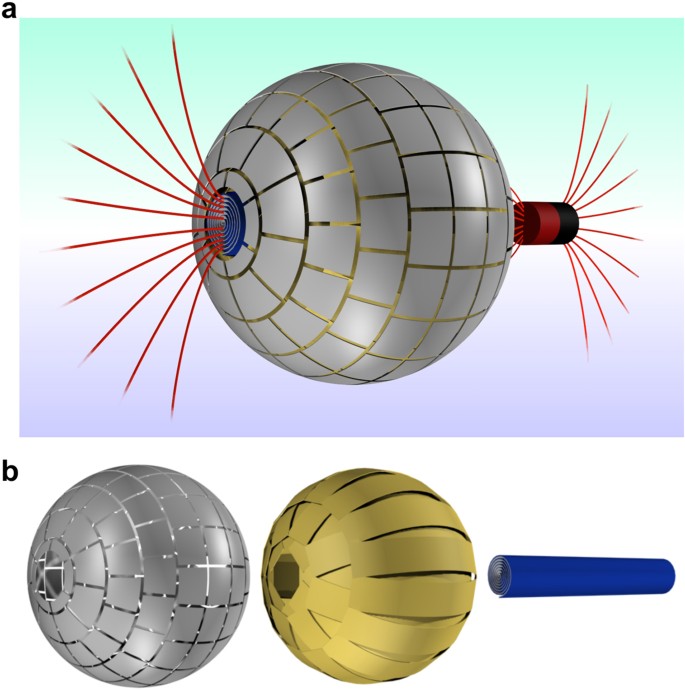Introduction
Wormholes are fascinating cosmological objects that can connect two distant regions of the universe.
Because of their intriguing nature, constructing a wormhole in a lab seems a formidable task. A
theoretical proposal by Greenleaf et al. presented a strategy to build a wormhole for electromagnetic
waves. Based on metamaterials, it could allow electromagnetic wave propagation between two
points in space through an invisible tunnel. However, an actual realization has not been possible
until now.

Constructing an artificial gravitational wormhole connecting two distant regions in the universe is an
apparently unrealizable challenge. Large amounts of negative gravitational energy would be required,
which makes impossible its realization with present technology. Greenleaf et al. presented a theoretical proposal for designing a wormhole for electromagnetic waves. Such an object could allow electromagnetic wave propagation between two points in space through an invisible tunnel. It would use
bulk metamaterials with complicated permeability and permittivity parameters. Actually, metamaterials
have enabled unprecedented control of electromagnetic waves, including some realizations mimicking
‘celestial’ objects.
Scientists construct an actual 3D wormhole for magnetostatic fields. It will allow the passage
of magnetic field between distant regions while the region of propagation remains magnetically invisible.
Prodcast episode
Working
The magnetostatic wormhole requires constructing a tunnel for magnetic fields acting as if was outside
the usual 3D space. The first property to be satisfied is to magnetically decouple a given volume from the surrounding 3D space. The volume enclosed by a superconducting shell has this property;
here a spherical superconducting shell . A second property is that the whole resulting wormhole cannot be magnetically detectable from its exterior. The superconducting spherical shell
would distort an applied field, and thus be detectable. A cylindrical magnetic cloak was made
consisting of a superconducting layer surrounded by a magnetic layer; similar bilayer structures have
been recently applied to thermal and diffusive cloak.
Scientists, by using metamaterial and metasurfaces to build their tunnel.
That meant that they could make the magnetic field from a source, such as a magnet or an electromagnet, appear at the other end of the wormhole with no trace of it in between.
This created the illusion that the magnetic field must be travelling through some kind of extra dimension. Oddly enough, it also meant that an isolated magnetic monopole – a magnet with only one pole, North or South – appeared randomly at the end of the tunnel.
“This result is strange enough in itself, as magnetic monopoles do not exist in nature,” a press release explained at the time.
“The overall effect is that of a magnetic field that appears to travel from one point to another through a dimension that lies outside the conventional three dimensions.”
To be clear, the wormhole in this experiment isn’t really invisible to the human eye – it’s a sphere made up of an outer ferromagnetic surface, an inner superconducting layer, and then a ferromagnetic sheet rolled into a cylinder internally.

passing through the magnetostatic wormhole; the whole spherical device is magnetically undetectable. B-The wormhole is composed of (from left to right) an outer spherical ferromagnetic metasurface, a
spherical superconducting layer, and an inner spirally wound ferromagnetic sheet
And while the tunnel isn’t anywhere near to the kind of wormhole that would take us across space, it does have a lot of features in common.
“[It] changes the topology of space, as if the inner region has been magnetically erased from space,” lead researcher Àlvar Sánchez explained.
The research has potential practical applications in areas that use magnetic fields – for example, it could lead to the creation of MRI machines that don’t require people to lie inside the claustrophobic machine, or more targeted MRI scans.
But importantly, it also teaches us more about ways we can tunnel our way through space – an endeavour that holds countless exciting possibilities.
The research was published in Scientific Reports.
How does superconducting levitation work?
A superconductor is essentially a substance that offers no electrical resistance and deflects magnetic fields. Superconductors had to be cooled to practically absolute zero when they were first discovered in 1911. The earliest superconductors were known, but they didn’t demonstrate superconductivity until temperatures below 10 Kelvin. Today, most superconductors are submerged in liquid nitrogen to…
The most powerful rocket fuel yet to exist!
When hydrogen is in its metallic phase, it takes on the characteristics of an electrical conductor. It can exist as a partial liquid rather than a solid at high pressures and temperatures. It may be abundant in the heated, gravitationally squeezed innards of Jupiter and Saturn, as well as some exoplanets and brown dwarfs, according…
Propulsion through Gravitational waves
Gravitational waves are produced from the merger of black holes, neutron stars or when a star goes supernova, causing a ripple in the fabric of space-time. Gravitational waves squeeze and stretch anything in their path as they pass and travel at the speed of light (186,000 miles per second). But what if we could use…




